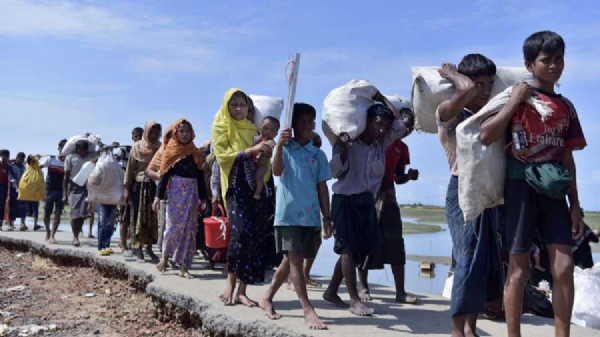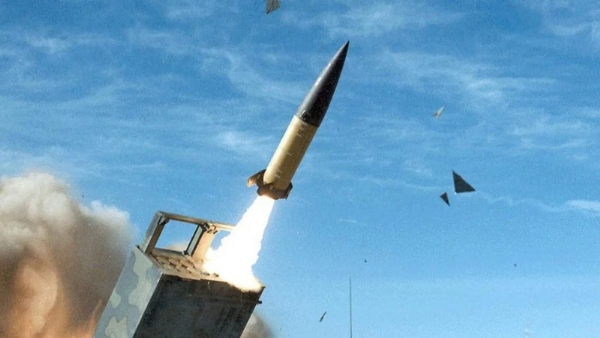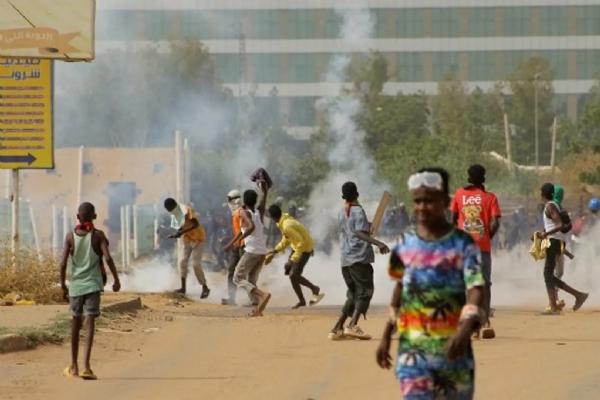#SecurityScan 101: The Wars of 2024, their lessons for India & more
A UN security assessment suggests both sides are actively replenishing their weapons, including drones, in preparation for a potentially decisive battle.
Total Views |
This article is a summary of important events that have taken place in last one week affecting, India's national security
Topics Covered
- A Comprehensive Approach to Restore Peace and Stability In Manipur
- Escalation Civil War in Myanmar In 2025
- The Wars of 2024: Projections for 2025: Lessons For India
- Israel-Gaza Conflict in 2025 and the Road Ahead
- The Russia-Ukraine Conflict: A Protracted Struggle Likely In 2025
- The Overthrow of Assad: A Turning Point in the Syrian Civil War
- The Brutal Sudanese Civil War Will Continue In 2025.

Countering external & Internal Security Challenges
A Comprehensive Approach to Restore Peace and Stability In Manipur
A Complex and Escalating Crisis
Manipur exemplifies the challenges of managing an internal security problem. The state faces a volatile mix of ethnic conflicts, tribal insurgency, drug trafficking, and infiltration from Myanmar. Despite India's proven expertise in addressing internal security issues—such as countering terrorism in Punjab, containing insurgency in the Northeast, and curbing Maoist rebellion—Manipur's situation has deteriorated alarmingly.
The Current Approach: A Flawed Strategy
The Government of India has primarily treated Manipur's crisis as a law-and-order issue. The recent deployment of 90 additional Central Armed Police Forces (CAPF) companies, alongside the imposition of the Armed Forces (Special Powers) Act (AFSPA) in select areas, has resulted in a saturation of security forces in the state. Despite these measures, the absence of political initiatives and confidence-building measures has allowed the crisis to deepen.
The Roots of the Conflict
The ethnic violence that erupted on May 3, 2023, between the Meiteis (majority in the Imphal Valley) and the Kuki-Zo tribals (residing in the surrounding hills) has led to significant loss of life and displacement.
- Casualties and Displacement: 258 deaths and over 60,000 displaced.
- Destruction of Religious Structures: 386 religious sites vandalized.
- Recent Escalation: Violent encounters, such as the killing of 10 militants on November 11, have reignited tensions. Subsequent protests and political fallout highlight the state government's inability to restore normalcy.
Lessons Ignored: The Need for a Holistic Approach
Effective management of tribal unrest requires more than forceful suppression. While controlling violence is essential, it must be accompanied by:
- Addressing grievances and reconciling differences.
- Forming peace committees at multiple levels.
- Taking political initiatives to inspire public confidence.The "Winning Hearts and Minds" (WHAM) approach, proven effective in counter-insurgency, has been underutilized.
Recommendations for Immediate Action
The situation demands decisive and multi-faceted interventions:
1. Prime Ministerial Visit: The Prime Minister should visit Manipur to signal commitment and initiate dialogue.
2. Imposition of President’s Rule: A dynamic governor with counter-insurgency experience should be appointed to lead the state.
3. Administrative Overhaul: Ineffective senior officers should be replaced with those willing to tackle the crisis fearlessly.
4. Uncompromising Integrity: A clear message should be conveyed that the integrity of Manipur is non-negotiable.
5. Targeted Actions Against Miscreants:
- Crackdown on individuals inciting or engaging in violence.
- Address attempts to communalize the conflict and vandalism of religious sites.
- Tackle drug trafficking with zero tolerance.
6. Disarmament Drive: A time-bound initiative to recover unlicensed and prohibited weapons, with violators facing strict penalties under the National Security Act.
7. Formation of Peace Committees: Establish district and state-level peace committees with representation from all communities to foster dialogue and reconciliation.
A Chance to Rebuild
While the Centre has lost precious time, it can still recover lost ground. Drawing inspiration from Chanakya’s wisdom—“We should not fret over the past, nor should we be anxious about the future. Men of discernment deal only with the present moment”—the Government of India must act decisively. Restoring peace in Manipur will be a challenging journey, but with sustained effort, it is achievable.
Escalation Civil War in Myanmar In 2025
The 2021 Coup and the Rise of Armed Resistance: Myanmar has been in turmoil since the 2021 military coup that ousted the democratically elected government of Aung San Suu Kyi. This action sparked widespread anger and fuelled a nationwide armed resistance movement against the junta. The fighting has intensified over the past year, with the fiercest resistance concentrated in regions populated by ethnic minorities. In these areas, various ethnic groups and civilian-led defense forces have formed alliances to challenge the military's control across significant portions of the country.
Rebel Gains and Military Setbacks:
While rebels have made progress throughout the war-torn nation, their advances are particularly notable in areas bordering China. The military has suffered a series of defeats, notably losing control of the western border with Bangladesh to the Arakan Army (AA) in December. The AA’s expulsion of the junta’s Border Guard Police (PGP5) from northern Rakhine State has given the rebels control of the entire 270-kilometer border. Only the state capital, Sittwe, remains under military control, effectively isolating it from the rest of the nation. The AA is poised to become the first insurgent group to achieve complete control of a state in Myanmar.
Humanitarian Crisis and Displacement:
The ongoing conflict has resulted in widespread devastation and human suffering. The UN High Commissioner for Human Rights, Volker Türk, reported that the military has killed over 5,000 civilians since 2021. The conflict has displaced over three million people nationwide, and approximately 18 million people – a third of the population – lack access to essential resources such as food, housing, electricity, and heating. The Rohingya population, already subjected to years of persecution, has been particularly affected. A Rohingya man described their current situation as even more difficult than under previous military juntas, with nearly 750,000 having fled to Bangladesh.

International Efforts and Future Outlook: China has advocated for a ceasefire, with two out of three members of the Brotherhood Alliance agreeing to it. While the insurgents have demanded the military's removal from politics, their primary focus may be consolidating their territorial gains. Myanmar's neighboring countries are increasingly concerned about the instability. Thailand hosted talks in December involving foreign ministers and high-level representatives from Myanmar, Laos, China, India, Bangladesh, and Thailand, aiming to resolve the political crisis. These efforts are unlikely to succeed without the military's genuine commitment to peace. The military is the root cause of the problems and warns against taking the junta's promises of future elections seriously. Aung San Suu Kyi, the 78-year-old Nobel laureate, remains under house arrest, facing a 27-year prison sentence on various charges, all of which she denies. The chief prosecutor of the International Criminal Court (ICC) has requested an arrest warrant for junta leader Min Aung Hlaing. The future of Myanmar remains uncertain, with the junta's ability to maintain control in 2025 – or even stage a comeback – in serious doubt.
The Wars of 2024: Projections for 2025: Lessons For India
Israel-Gaza Conflict in 2025
The Origins of the Current Conflict
The Israel-Gaza conflict escalated dramatically in October 2023 when Hamas militants launched a large-scale attack on southern Israel. The incursion resulted in over 1,200 Israeli deaths and 253 hostages being taken. Israel’s response was swift and severe, initiating an intense military campaign against Gaza that persisted throughout 2024.
Humanitarian Catastrophe in Gaza
The toll on Gaza has been devastating. Gaza health authorities report over 45,000 Palestinian fatalities, with nearly the entire population of 2.3 million displaced. Much of the territory has been reduced to rubble, creating a humanitarian crisis of unprecedented proportions.
International human rights organizations have condemned Israel’s actions. Amnesty International and Human Rights Watch have accused Israel of committing acts of genocide, including obstructing access to clean water in Gaza. The Israeli government has denied these allegations, asserting that it has facilitated water and humanitarian aid deliveries despite Hamas's continued attacks.
Hostage Crisis and Military Stalemate
Efforts to secure the release of more than 100 remaining hostages held by Hamas have largely failed. The hostages’ locations and health conditions remain unknown. According to the Council on Foreign Relations (CFR), these attempts have been hindered by the complexities of the ongoing conflict.
Calls for a Ceasefire and International Mediation
US and Arab negotiators have been tirelessly working to broker a ceasefire. Talks held in Egypt and Qatar have made progress in narrowing differences, but significant sticking points remain unresolved. Despite these efforts, the conflict continues, now entering its 14th month.
Legal and Political Implications
In November 2024, the International Criminal Court (ICC) issued arrest warrants for Israeli Prime Minister Benjamin Netanyahu and his former defense chief, accusing them of war crimes and crimes against humanity. While these developments have intensified global scrutiny, they have done little to alter the trajectory of the conflict.
Prospects for 2025: Will the War End?
There is cautious optimism that the war could end in 2025. Former US President Donald Trump, who is set to assume office again in January, has reportedly pressured Netanyahu to end the fighting before his inauguration. Trump’s directive, conveyed during a meeting at Mar-a-Lago, underscores the potential influence of international diplomacy on the conflict’s resolution.
The Future of Gaza
Post-war scenarios for Gaza remain uncertain. Netanyahu has stated that Israel will retain control of Gaza for the foreseeable future, with plans to establish a military buffer zone to prevent Hamas’s resurgence. The Israeli government has ruled out any administrative role for the Palestinian Authority in Gaza, further complicating prospects for peace.
Challenges of Reconstruction and Governance
Josef Federman, AP’s news director for the region, highlighted the immense challenges of rebuilding Gaza. With repeated cycles of destruction, securing investment for reconstruction will require significant changes in governance and international diplomacy.
Federman emphasized the need for a trusted authority to govern Gaza post-conflict, warning that any attempt to exclude Hamas entirely could undermine stability. The region’s future hinges on effective diplomacy and a willingness to address longstanding grievances.
Conclusion
As 2024 ends, the Israel-Gaza conflict remains a symbol of deep-seated animosities and geopolitical complexities. While there is hope for resolution in 2025, the path to lasting peace will require significant diplomatic breakthroughs and a commitment to addressing the root causes of the conflict.
The Russia-Ukraine Conflict: Protracted Struggle Likely In 2025
The Russia-Ukraine war, which began in February 2022, remained a dominant focus of global headlines in 2024. Over the course of the year, Russia made incremental gains in eastern Ukraine. By November, marking 1,000 days of the conflict, Russian forces had seized an additional 30 square kilometers of Ukrainian territory.
However, these advances have been slow and costly. The UK Ministry of Defence estimates Russia’s military casualties at 70,000 soldiers killed, with an additional 500,000 either killed or injured. Despite the losses, Russia continues to press forward.
Ukraine’s Counter-Offensive and the Nuclear Threat
In response, Ukraine launched counter-offensives into Russian territory. Notably, Kyiv claimed its forces encountered North Korean soldiers in Russia’s Kursk region—a claim that NATO has supported with evidence, though both Moscow and Pyongyang have denied it.

The conflict took a potentially dangerous turn when the United States authorized Ukraine to use long-range Army Tactical Missile Systems (ATACMS) against Russian targets. While experts argue that these missiles are not a strategic game-changer, Russia’s response was alarming. President Vladimir Putin lowered Russia’s nuclear threshold, warning NATO against further escalation.
Russia’s Ambitions for 2025
Looking ahead, Russia has set ambitious goals for 2025. According to Defense Minister Andrei Belousov, Moscow aims to fully capture Donetsk, Luhansk, Kherson, and Zaporizhzhia, territories central to its “special limited operation.” Experts believe Russia could achieve some of these objectives, particularly given the current challenges faced by Ukraine.
Ukraine’s Challenges: Internal and External Pressures
Ukraine’s situation appears increasingly dire. Former Ukrainian Foreign Minister Dmytro Kuleba warned that without significant changes, Ukraine risks losing the war. AP correspondent Samya Kullab described the conflict as a slow and devastating drain on Ukraine’s resources and morale.
Compounding Ukraine’s difficulties is the impending shift in U.S. leadership. With Donald Trump set to take office in January 2025, there is widespread concern about a potential reduction in American support for Kyiv. Trump, known for his transactional approach, may pressure Ukrainian President Volodymyr Zelenskyy to negotiate with Russia by threatening to cut military aid.
Prospects for Peace Talks
President Putin has expressed a willingness to negotiate with Trump and Ukraine’s legitimate authorities, though he has set strict conditions. In the past, Putin demanded that Ukraine withdraw from key regions, abandon its NATO aspirations, and formally recognize Crimea as Russian territory.
For any agreement to be binding, Putin insists it must involve Ukraine’s parliament and a legitimate leader. Zelenskyy, whose term has been extended due to martial law, would need re-election to satisfy Russia’s legal requirements for a deal.
European Support and the Path Forward
Despite America’s wavering stance, Europe remains steadfast in its support for Ukraine. In December, European foreign ministers pledged continued assistance. Kaja Kallas, the EU High Representative for Foreign Affairs, emphasized the need for Ukraine to shift the balance in its favor, stating that Putin “will not stop unless he’s stopped.”
The EU has maintained sanctions against Russian entities, but analysts argue that Europe must take a more active role. As The Guardian noted, Europe must step up to fill the potential void left by a retreating United States.
Strategic Options for Ukraine in 2025
Ukraine’s best hope may lie in buying time. Experts suggest Zelenskyy will need to balance negotiations with Russia while ensuring Ukraine’s frontlines remain intact. Simultaneously, Europe must demonstrate greater resolve and solidarity with its NATO allies.
In conclusion, while 2024 has been a year of attrition, the direction of the Russia-Ukraine conflict in 2025 will depend heavily on international dynamics, particularly the roles of the United States and Europe. As one commentator aptly put it, “In 2025, Europe will need to prove that it can walk the walk.”
The Overthrow of Assad: A Turning Point in the Syrian Civil War
The Genesis of the Conflict and Years of Stalemate: The Syrian civil war, erupting in 2011 from pro-democracy protests against Bashar al-Assad's regime, took a dramatic turn in late 2024. Assad, who had succeeded his father Hafez al-Assad (president since 1971) in 2000, was ultimately ousted by rebel forces led by Hayat Tahrir Al-Sham (HTS). The conflict, initially sparked by Assad's violent suppression of dissent, had resulted in an estimated 500,000 deaths and years of stalemate. As 2024 began, the situation remained largely unchanged: Sunni militants controlled northeast Syria, Kurdish forces backed by the US held the northwest, and Assad maintained control over the rest, including Damascus.
The Rapid Collapse of the Regime: The rebel offensive triggered international calls for de-escalation, with many, including the US (which designates HTS as a terrorist group), caught off guard by the rebels' rapid advances. Emboldened by their success in Aleppo, the rebels pressed forward, capturing strategically important cities like Hama, Daraa, and Homs, effectively splitting the Assad regime in two. On December 8, rebel forces entered Damascus, proclaiming the dawn of a new Syria. Assad subsequently fled to Moscow, where he was granted asylum. Millions of Syrian refugees began expressing their intention to return home.
International Reactions and Regional Implications: The US and allied actions had weakened Syria's backers—Russia, Iran, and Hezbollah. Experts predicted significant changes in West Asia in 2025. A US official suggested that the developments in Syria signalled the collapse of "Iran's artifice" in the region. Assad's demise represented a "fatal strike" on Iran's influence in the Middle East, dramatically weakening its ability to rebuild Hezbollah and threaten Israel. Iran would need to devise a new regional strategy without relying on proxies. The future of Syria, and its impact on neighboring countries like Turkey, Iraq, Jordan, Lebanon, and Israel, remained a central focus of international attention.
The Brutal Sudanese Civil War Will Continue In 2025
The Khartoum Clashes and the Eruption of War:

Sudan descended into civil war in April 2023, just before a planned transition to civilian rule. The conflict erupted in the capital, Khartoum, between the Sudanese Armed Forces (SAF) led by General Abdel Fattah al-Burhan and the paramilitary Rapid Support Forces (RSF) spearheaded by Mohamed Hamdan "Hemedti" Dagalo.
Escalating Conflict and Mounting Casualties:
As of 2024, the war has entered its second year, claiming nearly 15,000 lives and displacing over 8.2 million people – the largest displacement crisis globally. Experts believe the actual death toll is significantly higher due to limited registration of deaths in Sudan, especially during wartime. Intensified fighting has further hampered access to healthcare facilities, morgues, and cemeteries, hindering accurate death recording. Disruptions to communication networks have also isolated millions, making it difficult to assess the full extent of the crisis.
International Actors and Fuelling the Fire:
Russia and Iran have been major arms suppliers to the SAF, providing drones and other weapons. The United Arab Emirates (UAE) has emerged as a key supporter of the RSF, while China has provided weapons to both sides. International actors have acknowledged their involvement, with Malik Agar, al-Burhan's deputy, expressing gratitude for their assistance. Analysts like Magdi el-Gizouli highlight the dependence of both sides on external support due to Sudan's limited domestic arms production capacity.
A Looming Famine and a Humanitarian Catastrophe:
The war has triggered a severe humanitarian crisis. The UN estimates that nearly half of Sudan's population, approximately 25 million people, require immediate aid. Famine has begun to grip displacement camps, with over 11 million people forced to flee their homes. The UN warns of a potential "world's largest hunger crisis" unless urgent action is taken. The UN refugee agency, UNHCR, has confirmed famine in Darfur, a region with a long history of ethnic violence. The UN's humanitarian chief, Tom Fletcher, has called it an "invisible crisis" demanding immediate international attention. Around 3 million people have fled Sudan altogether, with over 2 million seeking refuge in neighboring Chad, Ethiopia, and South Sudan. Others have crossed into Egypt, Libya, Uganda, and Ethiopia.
Accusations of War Crimes and Ethnic Cleansing:
Both the SAF and the RSF have been accused of committing atrocities, including ethnic cleansing in Darfur by the RSF. Both sides have allegedly weaponized starvation as a war tactic. Sexual violence is reportedly rampant, with the UN labelling it an "epidemic." Both parties have vehemently denied these accusations.
The Vetoed Peace Resolution and Preparations for Further Conflict: The prospects for peace in Sudan appear bleak. In November 2024, Russia vetoed a UN Security Council resolution calling for an immediate ceasefire and unrestricted humanitarian aid access. This move was celebrated by the military-aligned Sudanese foreign ministry. A UN security assessment suggests both sides are actively replenishing their weapons, including drones, in preparation for a potentially decisive battle. The RSF, despite expressing willingness to collaborate with a new government, maintains control over its territories, creating a parallel power structure that challenges the internationally recognized government operating from Port Sudan.
External Interests and Potential Exploitation: Regardless of the victor in this brutal conflict, external actors are likely to exploit the situation. El-Gizouli suggests that Sudan presents an "easy win" for those seeking access to the Red Sea coast, political influence in Khartoum, and valuable mineral resources at a bargain price. The war, fuelled by international involvement, has inflicted immense suffering on the Sudanese population, and its devastating consequences are far from over.
--



